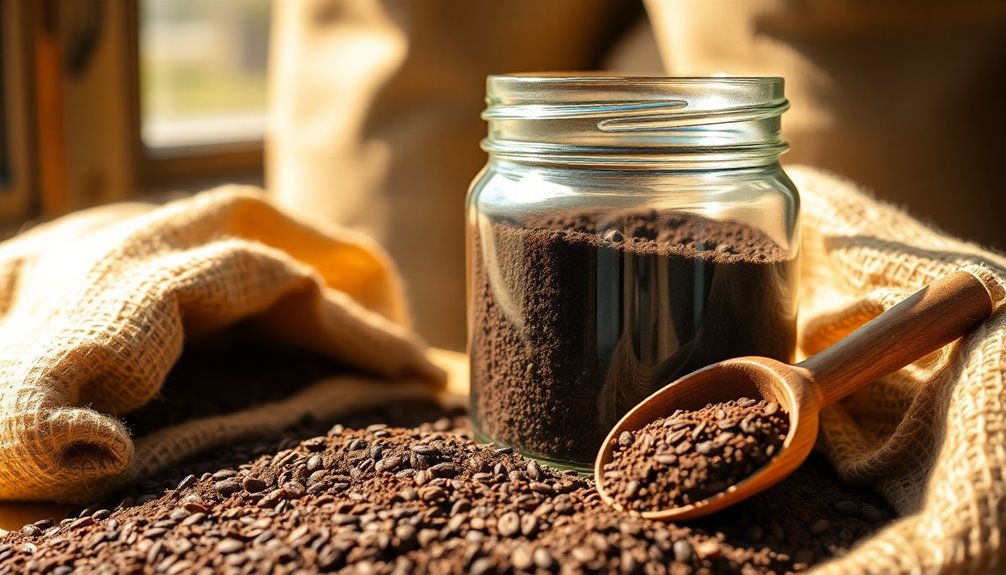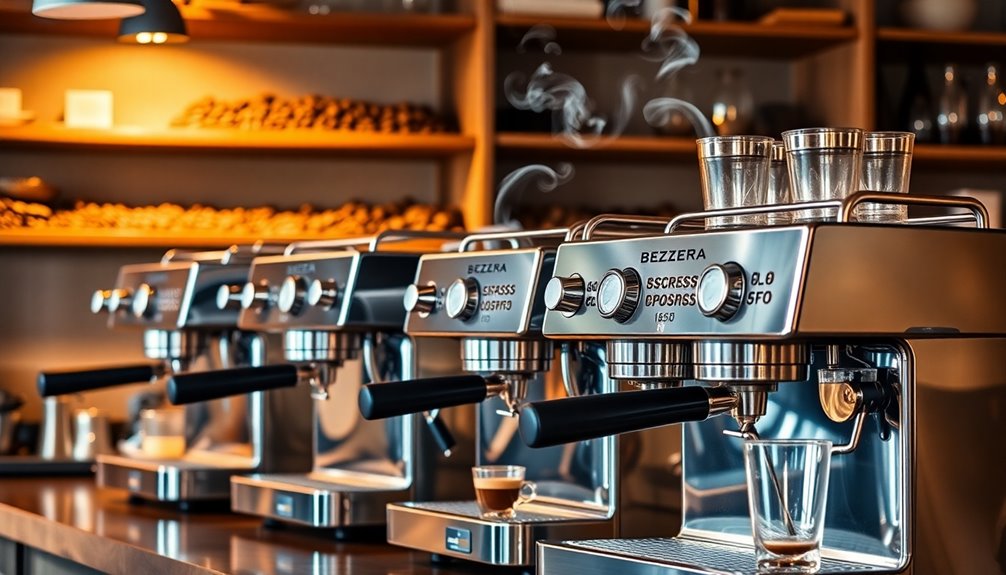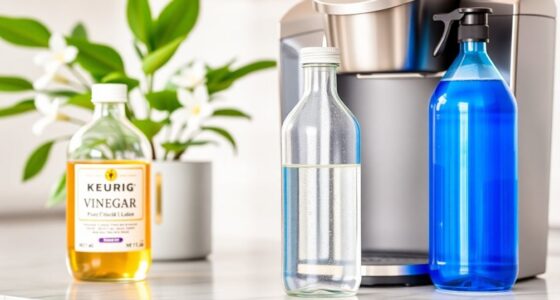To store coffee grounds effectively, keep them in an airtight container away from light and moisture. Choose opaque materials like ceramic or stainless steel for maximum protection. Avoid refrigerating your grounds, as condensation and odors can compromise their flavor. If you want to extend their shelf life, consider freezing them in smaller batches, but be sure to thaw them at room temperature. For the best taste, use older grounds first and check for signs of staleness regularly. There's much more to learn about maintaining the freshness and flavor of your coffee grounds to elevate your brewing experience.
Key Takeaways
- Use airtight containers made of stainless steel, ceramic, or bioplastics to preserve freshness and prevent oxygen exposure.
- Store coffee in a cool, dark place away from heat sources and humidity to maintain quality.
- Avoid refrigeration to prevent condensation and odor absorption, which can degrade flavor.
- Consider freezing coffee in small batches in airtight containers for extended shelf life, but allow it to thaw at room temperature.
- Regularly check for staleness and rotate your coffee stock, using older grounds first to ensure optimal flavor.
Choosing the Right Container

When it comes to storing coffee grounds, selecting the right container is essential for maintaining freshness.
Stainless steel canisters are a popular choice because they’re durable and shield your coffee from harmful UV rays. Stoneware containers like Le Creuset are also excellent, offering durability and dishwasher safety, except for the wooden lid. Avoid glass, as it exposes coffee to light, compromising freshness over time. For a sustainable option, consider bioplastics made from spent coffee grounds. Additionally, choose a size that suits your needs—whether it’s the large Planetary Design Airscape Kilo for bulk storage or the smaller Fellow Atmos for occasional use. Prioritize airtight seals and features like CO2 valves to keep your coffee at its best. Proper storage significantly affects coffee taste; exposure to sunlight and oxygen reduces shelf life, making effective storage solutions crucial for preserving freshness. As you consider your coffee storage options, also think about how you typically brew your coffee. If you often use a Chemex, be sure to look for canisters with enough room to accommodate Chemex filter options. This will make it easier to keep all of your coffee essentials in one convenient place. Additionally, consider a storage option that allows for easy access to your coffee beans or grounds, as well as a design that complements your kitchen decor.
Ideal Storage Environment
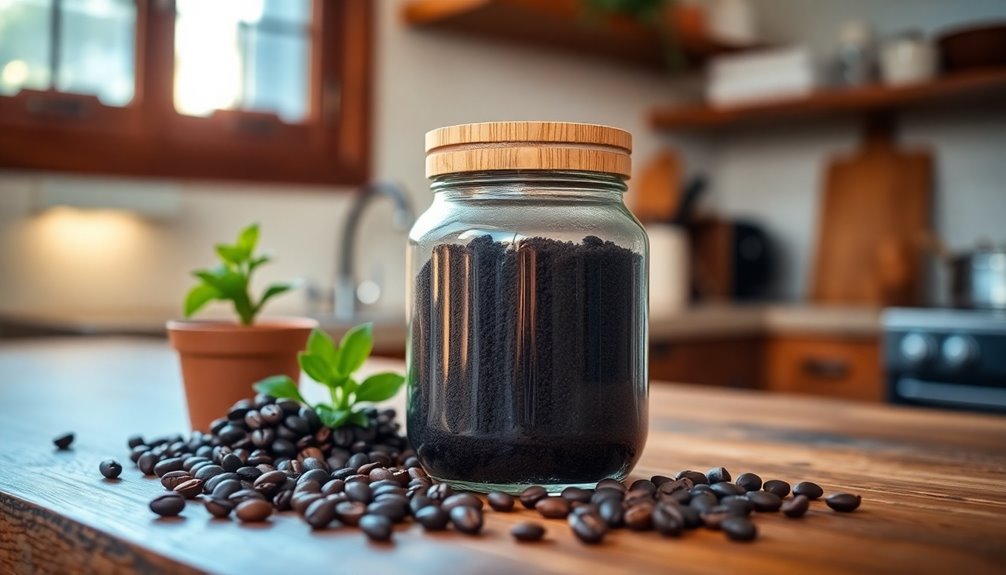
Where should you store your coffee grounds for ideal freshness? Keep them in a cool, dry place, away from heat sources like stoves or ovens. Pantries or cupboards at room temperature work best. Avoid extreme temperatures, including freezing conditions, to maintain flavor. Minimize light exposure by storing your coffee grounds in opaque containers, shielding them from UV rays. Cabinets or cupboards that aren't exposed to direct sunlight are perfect. Control humidity levels, aiming for 50-70% relative humidity. This stability helps prevent moisture gain or loss, which can affect flavor. Avoid high-humidity areas to prevent mold and guarantee proper ventilation. Additionally, using air-tight containers can further reduce oxygen exposure and preserve the freshness of your coffee grounds.
Risks of Refrigeration
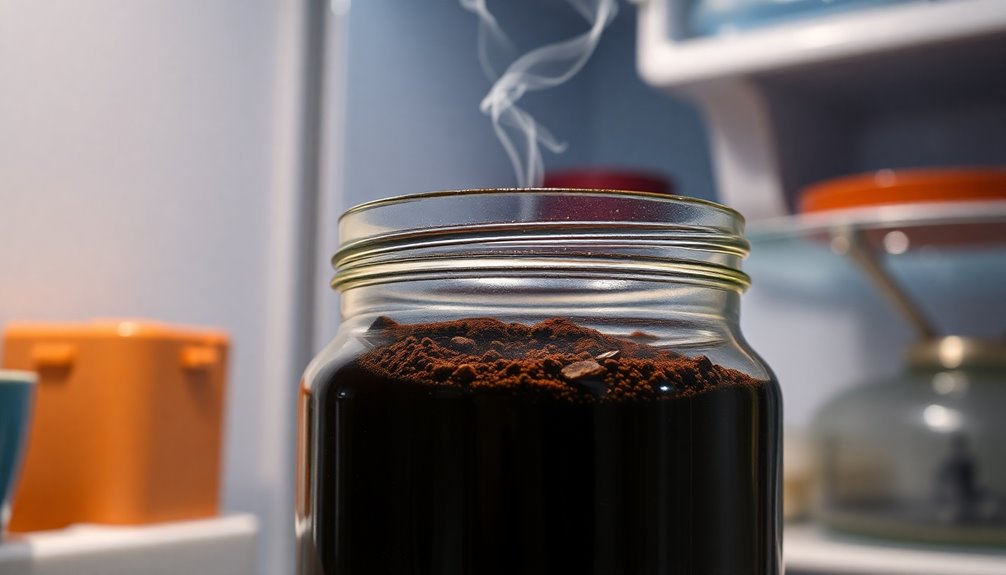
While refrigeration might seem like a good idea for preserving your coffee grounds, it poses several risks that can compromise their freshness and flavor.
The cold environment often leads to condensation, introducing moisture that makes your coffee grounds stale and dusty. Each time you take the coffee in and out, temperature fluctuations worsen this issue, causing further degradation of flavor and aroma. Additionally, fresh coffee grounds should be stored in a cool, dry, dark cupboard to minimize oxidation.
Additionally, your coffee can absorb unwanted odors from other foods in the fridge, altering its taste. Mold and bacteria can thrive in high humidity, making your coffee grounds unsafe.
Freezing Coffee Grounds
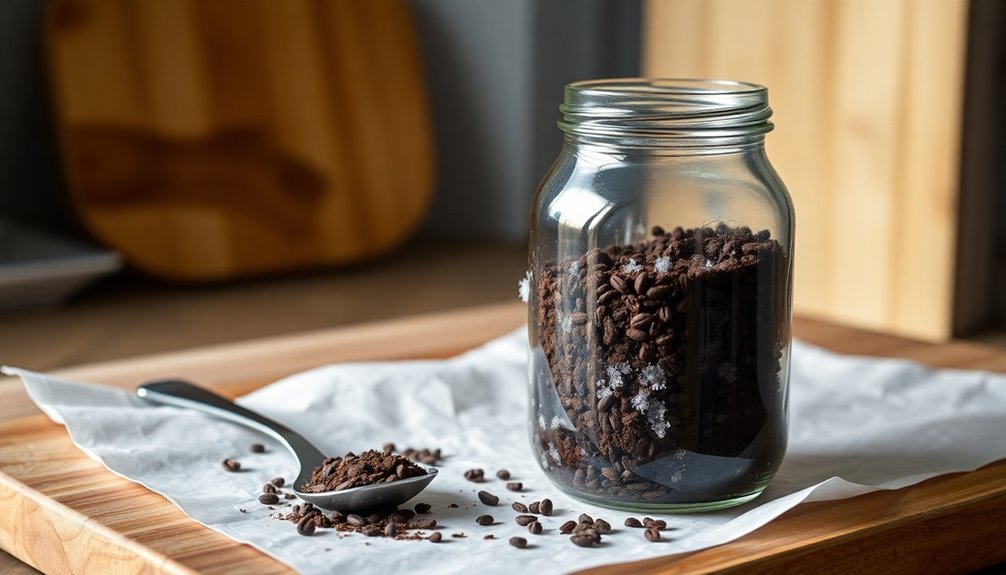
If you're considering freezing coffee grounds to extend their shelf life, it's important to know that this method can be effective but comes with some caveats.
Freezing can preserve your coffee for 6-12 months, but it mightn't maintain peak flavor. To do it right, use an airtight container or zip-lock freezer bag to keep out moisture and odors. Locking out moisture is crucial to prevent degradation during storage.
Divide your coffee into smaller batches to minimize disturbance, and store it without opening until you're ready to brew.
When you're ready to use them, thaw the grounds at room temperature for about an hour—never in the microwave.
Factors Affecting Freshness

To keep your coffee grounds fresh, you need to understand the key factors that can impact their longevity.
First, oxygen exposure is a major culprit; using airtight containers and dividing your coffee into smaller portions can help limit this. Avoid transparent containers that allow light in, as light can accelerate oxidation. Whole beans last longer than ground coffee due to reduced oxygen exposure, making them a better option for long-term storage.
Additionally, moisture is another enemy. Always store your grounds in a dry, airtight container and consider using silica gel packs to absorb excess moisture.
Finally, temperature plays an essential role—keep your coffee in a cool, consistent place, away from heat sources like ovens.
Proper Handling Techniques
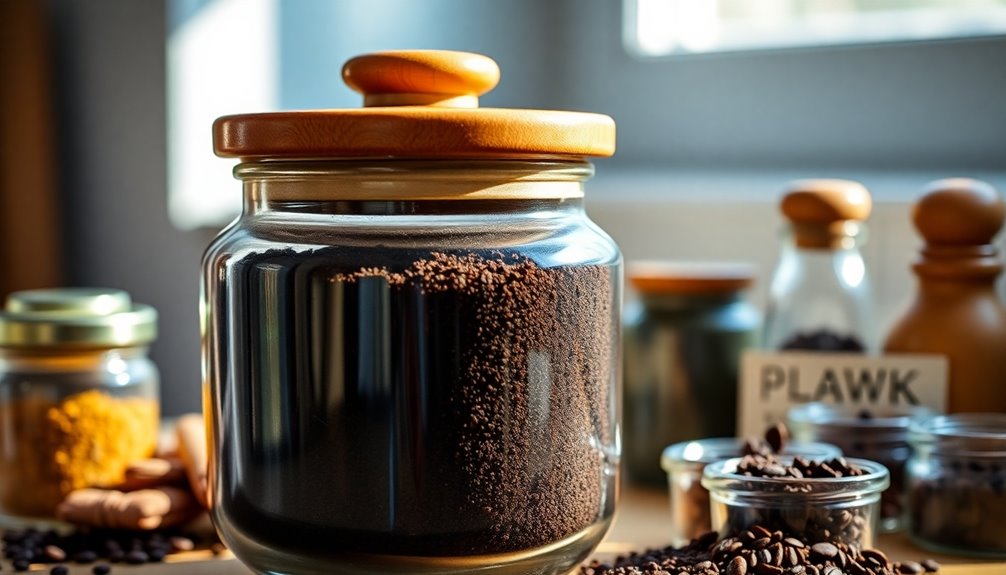
Understanding how to store coffee grounds is only part of the equation; proper handling techniques also play an essential role in maintaining their freshness.
First, always choose a cool, dry place for storage, avoiding areas exposed to moisture or heat, like the refrigerator or stove. Fresh coffee loses flavor quickly after grinding, so it's crucial to consume it promptly to enjoy its optimal taste.
Use airtight containers made from non-reactive materials such as glass or ceramic to keep moisture and odors out.
When you're ready to use your coffee, make certain to close the container tightly after each use.
Aim to finish your ground coffee within 1-2 weeks for the best flavor.
If you opt to freeze your coffee, verify it's vacuum-sealed and stored in an airtight container to prevent moisture damage.
Grinding for Freshness
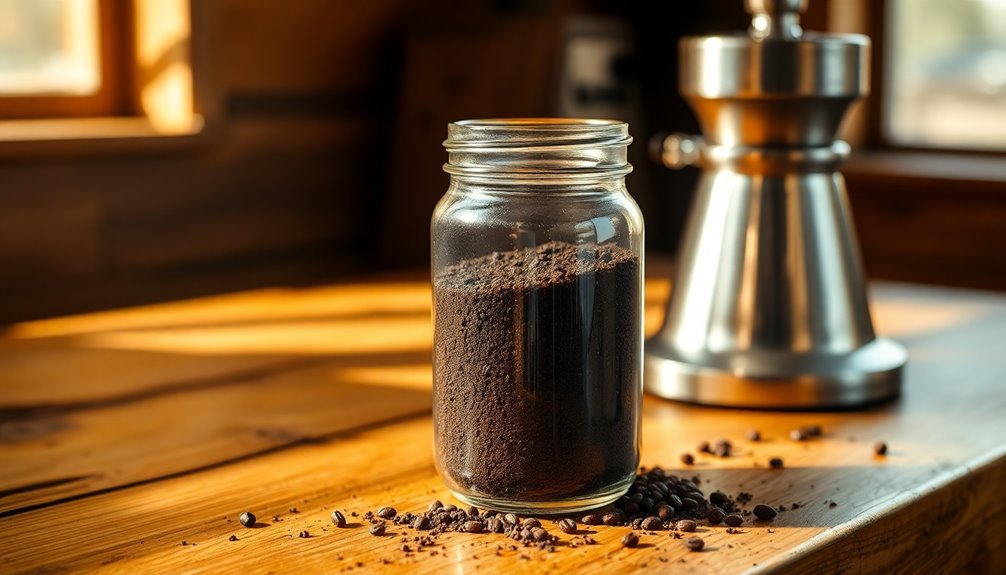
While many factors influence the quality of your coffee, grinding your beans fresh is one of the most important steps you can take to enhance flavor.
Once you grind coffee, oxidation begins, releasing oils and aromatics that contribute to its taste. Ground coffee has a larger surface area exposed to oxygen, leading to quicker flavor loss. Additionally, investing in a quality grinder, such as a burr grinder, can greatly improve your coffee experience.
Grinding just before brewing gives you control over the final taste, allowing you to adjust the grind size for different brewing methods. For instance, use a coarse grind for French Press and a fine grind for espresso.
A burr grinder is recommended for consistent results, but even a blade grinder can work. Just remember to measure your beans for ideal flavor extraction.
Storage Duration Guidelines
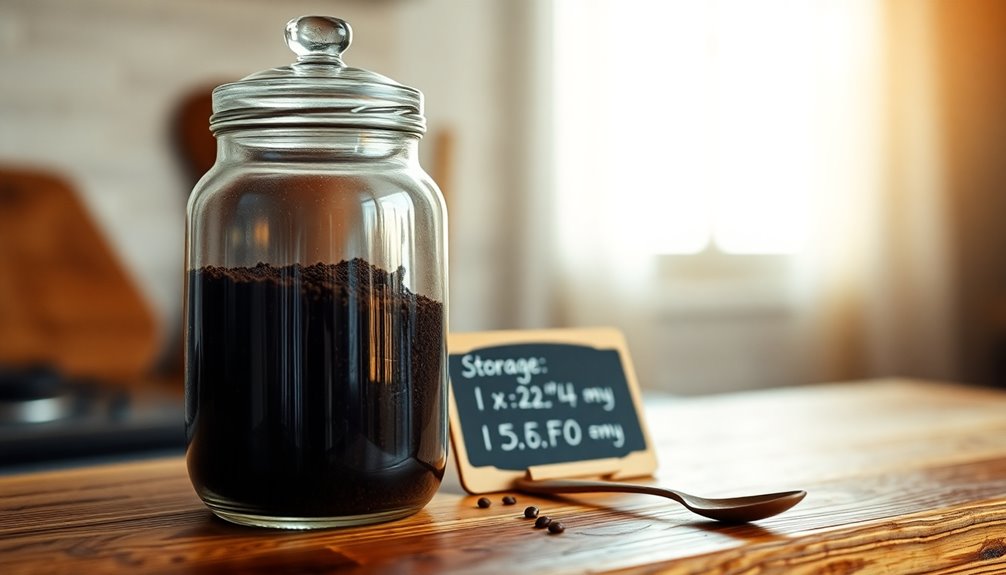
Many coffee lovers wonder how long ground coffee will stay fresh after it's been opened. When stored properly, you can expect your ground coffee to stay fresh for about 1-2 weeks. For the best flavor, try to use it within a week of grinding. If you live in a humid environment, refrigerating your coffee can extend its freshness up to 2 weeks, but make sure it's in a sealed container to keep moisture out. If you want to store it longer, freezing is a great option; ground coffee can last up to a month in the freezer. Just remember, even with proper storage, ground coffee will gradually lose its flavor over time, so enjoy it while it's fresh! Additionally, proper storage is crucial for maintaining the freshness of your coffee grounds, as exposure to air can deteriorate their quality.
Selecting Container Size

When choosing the right container size for your coffee grounds, it's important to take into account how much you consume regularly. Ideally, select a container that holds enough coffee for about 2-3 weeks. This helps minimize excess air exposure, which can compromise freshness and flavor. Airtight containers are particularly beneficial in preserving the quality of your coffee grounds.
You'll find various capacity options, such as 0.4, 0.7, and 1.2 liters, but if you buy in bulk, consider using multiple smaller containers to maintain the quality. Large canisters like the Airscape Kilo can hold up to 2.2 pounds, but be cautious—too large a container can lead to stale coffee over time.
Choose a size that matches your consumption to guarantee your coffee stays fresh and enjoyable.
Maintaining Flavor and Aroma

To keep your coffee grounds fresh and flavorful, it's vital to store them properly. Use an airtight container to shield your grounds from oxygen, which can diminish their taste and aroma. Choose ceramic, metal, or glass options, but make sure they're tightly sealed after each use. Keep your container in a cool, dark place, away from direct sunlight and heat sources, as temperature fluctuations can negatively impact quality. Proper storage can preserve flavor for up to six months when done correctly. Avoid moisture, too; don't refrigerate or store your grounds in humid areas, as this can lead to mold. Finally, opt for opaque containers to minimize light exposure, which accelerates degradation.
Frequently Asked Questions
Can I Store Coffee Grounds in a Plastic Container?
You can store coffee grounds in a plastic container, but make certain it's BPA-free to avoid any chemical contamination.
High-quality, food-safe plastic is crucial, as lower-grade options can transfer unwanted flavors.
Choose a container with an airtight seal to keep moisture and odors out.
Ideally, place it in a cool, dry spot, away from sunlight.
Regularly check the container for any wear and confirm it stays in good condition for peak freshness.
How Do I Know if My Coffee Has Gone Stale?
To know if your coffee has gone stale, pay attention to its taste, smell, and appearance.
If it lacks flavor, tastes overly bitter, or has a flat, lifeless quality, it's likely stale. A musty or cardboard smell signals freshness loss.
Visually, look for dull colors or oily surfaces. If you notice mold or fuzzy patches, it's definitely time to toss it.
Trust your senses; they'll guide you to the right decision!
Is It Safe to Use Old Coffee Grounds for Baking?
Yes, it's safe to use old coffee grounds for baking, as long as they haven't developed mold or an off smell.
While they might lack the robust flavor of fresh grounds, they can still add a subtle coffee taste to your recipes.
Just keep in mind that the older the grounds, the less potent the flavor.
If you're not aiming for a strong coffee flavor, using stale grounds can work just fine.
Can I Reuse Coffee Grounds for a Second Brew?
You can technically reuse coffee grounds for a second brew, but it's not the best idea.
Most of the flavors and oils are extracted during the first brew, leading to a bitter and weak cup.
You'll notice a significant drop in caffeine content and flavor.
If you're after a great-tasting coffee experience, stick to fresh grounds for that rich aroma and robust flavor you love.
What's the Best Way to Dispose of Used Coffee Grounds?
When you're looking to dispose of used coffee grounds, don't just toss them in the trash. Instead, consider composting them; they're a rich source of nitrogen that can enrich your compost pile.
You can also repurpose them as a natural deodorizer or even a gentle exfoliant for your skin.
Conclusion
To sum up, storing your coffee grounds properly is key to preserving their flavor and aroma. By choosing the right container, maintaining an ideal environment, and understanding the risks of refrigeration, you can keep your grounds fresh for longer. Remember to grind just what you need for maximum freshness and follow the storage duration guidelines. With these tips, you'll enjoy a better cup of coffee every time. Happy brewing!
